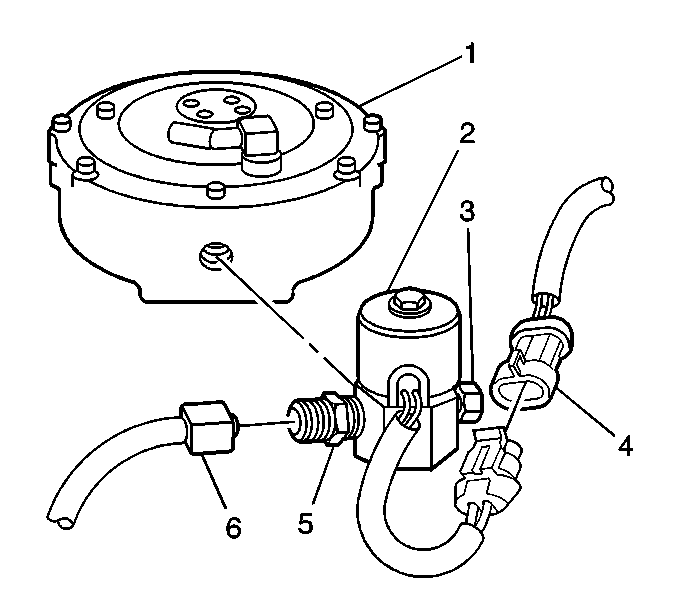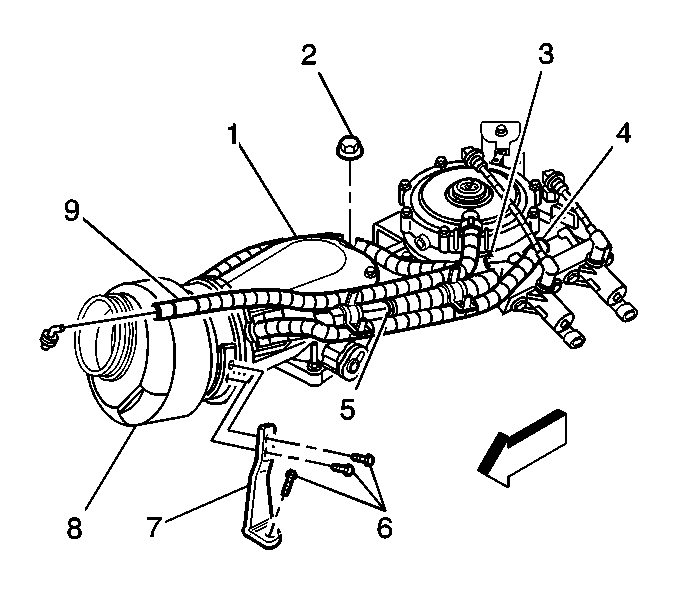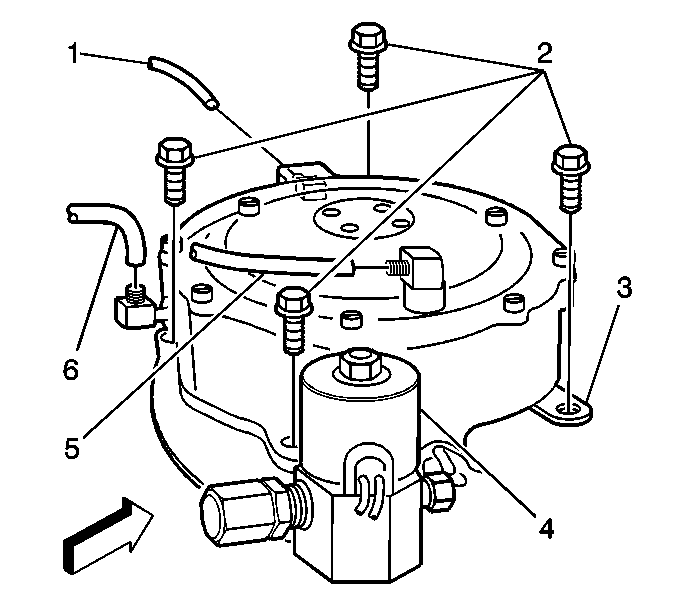Tools Required
J 41416 Ultrasonic Leak Detector
Removal Procedure
- Relieve the CNG fuel system pressure. Refer to the Fuel Pressure Relief .
- Disconnect the negative battery cable. Refer to Battery Negative Cable Disconnection and Connection in Engine Electrical in the G Van Service Manual.
- Remove the engine cover. Refer to Engine Cover Replacement in Interior Trim in the G Van Service Manual.
- Disconnect the fuel line (6) at the LPL fitting (5).
- Disconnect the LPL connector (4).
- Remove the spring clamp from the fuel outlet hose (5) at the LPR fitting.
- Disconnect the idle control solenoid hose (6).
- Disconnect the fuel control solenoid hose (5).
- Disconnect the LPR reference hose (1).
- Remove the mounting bolts (2).
- Remove the LPR from the vehicle.
- Remove the low pressure lock-off solenoid and bracket from the LPR if necessary. Refer to Low Pressure Lock-Off Solenoid Replacement .
- Remove the LPR bracket (2) nuts (1) if bracket removal is necessary.
Caution: Natural gas is highly flammable. In order to reduce the risk of fire and personal injury, keep sparks, flames, and smoking materials away from the vehicle while you perform the Compressed Natural Gas (CNG) fuel system service.
Caution: The Compressed Natural Gas (CNG) system operates at pressures up to 24820 kpa (3600 psi). Relieve the CNG fuel system pressure before servicing CNG fuel system components in order to reduce the risk of fire and personal injury.
Caution: Unless directed otherwise, the ignition and start switch must be in the OFF or LOCK position, and all electrical loads must be OFF before servicing any electrical component. Disconnect the negative battery cable to prevent an electrical spark should a tool or equipment come in contact with an exposed electrical terminal. Failure to follow these precautions may result in personal injury and/or damage to the vehicle or its components.




Installation Procedure
- Install the LPR bracket (2) onto the intake manifold (3) studs if necessary.
- Install the LPR bracket nuts (1).
- Install the low pressure lock-off solenoid and bracket to the LPR if necessary. Refer to Low Pressure Lock-Off Solenoid Replacement .
- Place the LPR onto the engine bracket.
- Install the mounting bolts (2).
- Connect the LPR reference hose (1).
- Connect the fuel control solenoid hose (5).
- Connect the idle control solenoid hose (6).
- Install the spring clamp to the fuel outlet hose (5) at the LPR fitting.
- Connect the fuel line (6) at the LPL fitting (5).
- Connect the LPL connector (4).
- Connect the negative battery cable. Refer to Battery Negative Cable Disconnection and Connection in Engine Electrical in the G Van Service Manual.
- Prime the CNG fuel system by cycling the ignition ON and OFF several times.
- Start the engine and use the J 41416 in order to inspect for CNG fuel system leaks at each serviced fitting.
- Inspect for proper coolant level and fill as necessary.

Notice: Use the correct fastener in the correct location. Replacement fasteners must be the correct part number for that application. Fasteners requiring replacement or fasteners requiring the use of thread locking compound or sealant are identified in the service procedure. Do not use paints, lubricants, or corrosion inhibitors on fasteners or fastener joint surfaces unless specified. These coatings affect fastener torque and joint clamping force and may damage the fastener. Use the correct tightening sequence and specifications when installing fasteners in order to avoid damage to parts and systems.
Tighten
Tighten the nuts to 11 N·m (97 lb in).

Tighten
Tighten the mounting bolts to 12 N·m (106 lb in).


Tighten
Tighten the fuel line fitting to 37 N·m (27 lb ft).
